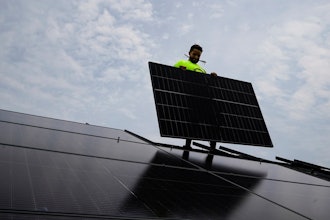WASHINGTON (AP) -- President Barack Obama's new pollution limits for power plants have set off an avalanche of information about what the rules will cost, how they will affect your health and how far they will go toward curbing climate change.
There's just one problem: Almost none of it is based in reality.
That's because Obama's proposed rules, which aim to cut carbon dioxide emissions from power plants 30 percent by 2030, rely on states developing their own customized plans to meet their targets. Among the options are switching to cleaner fuel sources, boosting efficiency to reduce demand for electricity and trading pollution permits through cap-and-trade.
At the earliest, states won't submit plans until mid-2016; some states could have until 2018. So the true impact won't be known for years.
But that's not stopping the White House, environmental groups and the energy industry from serving up speculation in heaping doses.
What we know and don't know about the effects of the pollution rules:
___
ELECTRICITY PRICES
The Obama administration says: The proposal will shrink electricity bills about 8 percent.
Supporters of energy deregulation say: "Americans can expect to pay $200 more each year for their electricity." — Institute for Energy Research, a group backed by the Koch brothers.
The reality: It depends how you crunch the numbers. The administration acknowledges that the price per kilowatt hour will go up a few percentage points. But the administration says your total power bill will be lower because the plan incentivizes efficiency and will drive down demand. In other words, you'll pay more for the electricity you buy, but you'll buy less of it.
___
THE ENVIRONMENT
Environmentalists say: "This is the biggest step we've ever taken for the biggest challenge we've ever faced." — League of Conservation Voters
The coal industry says: "The proposal will have practically no effect on global climate change." — American Coalition for Clean Coal Electricity
The reality: The plan would prevent about 430 million tons of carbon from reaching the atmosphere. It's a 30 percent cut over the next 15 years, but that's compared with 2005 levels. Since 2005, power plans have cut those emissions nearly 13 percent, so they're already about halfway toward the goal.
But U.S. fossil-fueled plants account for only 6 percent of global carbon emissions, and Obama's plan doesn't touch the rest of the world's emissions. It won't cut as big a chunk as Obama's previous fuel economy rules for cars and trucks.
___
THE ECONOMY
The U.S. Chamber of Commerce says: The plan will cost the economy more than $50 billion per year.
The administration says: By 2030, the rules will have an annual cost of up to $8.8 billion, but that cost will be far offset by annual climate and health benefits of up to $93 billion.
The reality: We won't know until states decide how to meet their targets. Some states rely more heavily on coal, so different regions will be affected in different ways. Still, it's a safe bet that companies that produce natural gas, solar panels or renewable technologies will get a boost, while coal will take a hit.
To calculate health care savings, the administration uses a somewhat morbid formula that puts a dollar amount on ailments averted — everything from heart attacks to bronchitis and asthma. It's an inexact science, and there are plenty of caveats.
___
JOBS
The conservative Heritage Foundation says: "Nearly 600,000 jobs would be lost."
The United Mine Workers of America says: "We estimate that the total impact will be about 485,000 permanent jobs lost."
The Environmental Protection Agency says: The rules could cost close to 80,000 jobs by 2030 at power plants and fossil fuel companies, but could create about 111,000 jobs in energy efficiency.
The reality: It's tough to tell. Not every coal miner who loses a job will find work installing solar panels and windmills. On the other hand, the low cost of natural gas has already prompted a shift away from coal, meaning some of those jobs will disappear with or without new pollution limits.
___
PUBLIC HEALTH
The EPA says: Up to 6,600 premature deaths, 150,000 asthma attacks in children and close to half a million sick days will be averted.
The American Lung Association says: "Cleaning up carbon pollution from power plants will save lives and have an immediate, positive impact on public health."
The coal industry says: "The White House continues to perpetuate the nonexistent linkage between EPA's new carbon regulations and public health." — American Coalition for Clean Coal Electricity
The reality: Even the EPA says that the quantitative health benefits of the new rule are "illustrative examples." It's true that carbon dioxide emissions aren't directly linked to health problems like asthma. But because the rule will decrease the amount of electricity made from burning coal, it will help reduce other pollutants that coal-fired power plants release. Those pollutants create smog and soot, which do cause health problems.
Critics contend the administration is "double counting" those benefits.
Associated Press writer Dina Cappiello contributed to this report.






















